Unsymmetrical - Study guides, Class notes & Summaries
Looking for the best study guides, study notes and summaries about Unsymmetrical? On this page you'll find 56 study documents about Unsymmetrical.
Page 2 out of 56 results
Sort by
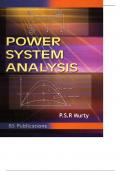
-
ELECTRICITY: Power System Analysis
- Exam (elaborations) • 336 pages • 2024
-
- $18.99
- + learn more
Contents Preface .................................................................................................................. (vii) Acknowledgment ................................................................................................... (ix) 1 Introduction I. I The Electrical Power System .................................................................. I 1.2 Network Models ...................................................................................... 3 1.3 Faults ...
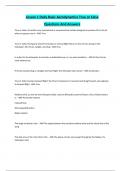
-
Lesson 1 Daily Basic Aerodynamics True or False Questions And Answers
- Exam (elaborations) • 3 pages • 2023
- Available in package deal
-
- $11.99
- + learn more
Lesson 1 Daily Basic Aerodynamics True or False Questions And Answers True or False: An airfoil is any symmetrical or unsymmetrical surface designed to produce lift or thrust when air passes over it - ANS-True True or False: During any kind of horizontal or vertical flight there are four forces acting on the helicopter; lift, thrust, weight, and drag - ANS-True In order for the helicopter to maintain a stabilized hover in a no wind condition: - ANS-All four forces must balance out If...
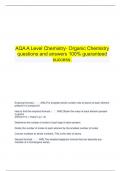
-
AQA A Level Chemistry- Organic Chemistry questions and answers 100% guaranteed success.
- Exam (elaborations) • 14 pages • 2024
-
- $13.49
- + learn more
AQA A Level Chemistry- Organic Chemistry questions and answers 100% guaranteed success. Empirical formula - ANS.The simplest whole number ratio of atoms of each element present in a compound How to find the empirical formula - ANS.Obtain the mass of each element present in grams (Element % = mass in g = m) Determine the number of moles of each type of atom present Divide the number of moles of each element by the smallest number of moles Co...

-
McMurry Organic Chemistry (9th Edition), Chapter 2, Definitions Test Questions Accurately Solved.
- Exam (elaborations) • 6 pages • 2024
-
Available in package deal
-
- $12.99
- + learn more
Acidity Constant (Ka) - correct answer (Section 2-8): A measure of acid strength. For any acid HA, the acidity constant is given by the expression Brønsted-Lowry Acid - correct answer (Section 2-7): A substance that donates a hydrogen ion (proton; H+) to a base. Brønsted-Lowry Base - correct answer (Section 2-7): A substance that accepts H+ from an acid. Conjugate Acid - corr...

-
chem210:exam1 study guide, complete verified solution, A+ guarantee, 2024.
- Exam (elaborations) • 6 pages • 2024
-
- $11.79
- + learn more
chem210:exam1 study guide, complete verified solution, A+ guarantee, 2024. properties of organic compounds non-polar; flammable; covalent bonds; insoluble in water; carbon containing molecules; non-conductor in electrolytes; LOW boiling and melting points; gas at room temp. properties of inorganic compounds polar; non-flammable; ionic bonds; soluble in water; conducts electricity; solid at room temp; HIGH boiling/melting points What is the trend in solubility and boiling point/melting...

-
HEENT Assessment Already Graded A+
- Exam (elaborations) • 8 pages • 2024
-
- $11.99
- + learn more
HEENT Assessment Already Graded A+ How do we assess the neck? We auscultate major blood vessels Why do we auscultate the neck? To detect bruits**, which are abnormal arterial sounds, similar to murmurs, cause be increased turbulence over major blood vessels, such as the carotid artery. Why do bruits occur? When an artery is partially obstructed or distended, which prevents blood f low from moving straight through the vessel What are some questions to ask before doing a HEE...
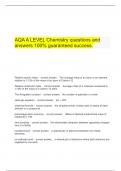
-
AQA A LEVEL Chemistry questions and answers 100% guaranteed success.
- Exam (elaborations) • 9 pages • 2024
-
- $15.49
- + learn more
AQA A LEVEL Chemistry questions and answers 100% guaranteed success. Relative atomic mass - correct answer. The average mass of an atom of an element, relative to 1/12th of the mass of an atom of Carbon-12 Relative molecular mass - correct answer. Average mass of a molecule compared to 1/12th of the mass of a carbon-12 atom The Avogradro constant - correct answer. the number of particles in a mole ideal gas equation - correct answer. pV = nRT empirica...
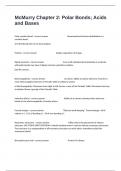
-
McMurry Chapter 2: Polar Bonds; Acids and Bases Certification Review Exam Questions And Answers Verified Solutions.
- Exam (elaborations) • 2 pages • 2024
-
Available in package deal
-
- $12.99
- + learn more
Polar covalent bond - correct answer Unsymmetrical electron distribution in a covalent bond. Are directional (due to set bond angles). Polarity - correct answer Implies separation of charge. Dipole moment - correct answer Sum of all individual bond polarities.A molecule with polar bonds may have 0 dipole moment; polarities combine just like vectors. Electronegativity - correc...
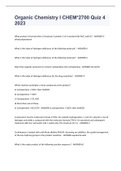
-
Organic Chemistry I CHEM*2700 Quiz 4 exam 2023 with 100% correct answers
- Exam (elaborations) • 9 pages • 2023
-
- $11.49
- + learn more
Organic Chemistry I CHEM*2700 Quiz 4 2023 What product is formed when 3-vinylcyclo-2-penten-1-ol is reacted with Pd/C and H2? - ANSWER-3-ethylcyclopentanol What is the index of hydrogen deficiency of the following molecule? - ANSWER-6 What is the index of hydrogen deficiency of the following molecule? - ANSWER-2 Select the reagents necessary to convert cyclopentene into cyclopentane - ANSWER-H2 and Ni What is the index of hydrogen deficiency for the drug morphine? - ANSWER-9 ...
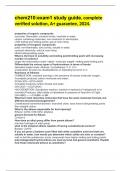
-
chem210:exam1 study guide, complete verified solution, A+ guarantee, 2024.
- Summary • 6 pages • 2024
-
- $10.49
- + learn more
chem210:exam1 study guide, complete verified solution, A+ guarantee, 2024. properties of organic compounds non-polar; flammable; covalent bonds; insoluble in water; carbon containing molecules; non-conductor in electrolytes; LOW boiling and melting points; gas at room temp. properties of inorganic compounds polar; non-flammable; ionic bonds; soluble in water; conducts electricity; solid at room temp; HIGH boiling/melting points What is the trend in solubility and boiling point/melting...

How much did you already spend on Stuvia? Imagine there are plenty more of you out there paying for study notes, but this time YOU are the seller. Ka-ching! Discover all about earning on Stuvia


